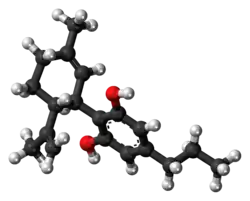 | |
 | |
| Clinical data | |
|---|---|
| ATC code |
|
| Identifiers | |
| |
| CAS Number | |
| PubChem CID | |
| DrugBank | |
| ChemSpider | |
| UNII | |
| KEGG | |
| ChEMBL | |
| CompTox Dashboard (EPA) | |
| ECHA InfoCard | 100.236.933 |
| Chemical and physical data | |
| Formula | C19H26O2 |
| Molar mass | 286.415 g·mol−1 |
| 3D model (JSmol) | |
| |
| |
| | |
Cannabidivarin (CBDV, GWP42006) is a non-intoxicating psychoactive cannabinoid found in Cannabis. It is a homolog (chemistry) of cannabidiol (CBD), with the side-chain shortened by two methylene bridges (CH2 units).
Although cannabidivarin (CBDV) is usually a minor constituent of the cannabinoid profile, enhanced levels of CBDV have been reported in feral populations of C. indica ( = C. sativa ssp. indica var. kafiristanica) from northwest India, and in hashish from Nepal.[1]=[2][3]
CBDV demonstrated anticonvulsant in rodent models in a single published study.[4] It was identified for the first time in 1969 by Vollner et al.[5]
Similarly to CBD, it has seven double bond isomers and 30 stereoisomers (see: Cannabidiol#Isomerism). It is not scheduled by Convention on Psychotropic Substances. It is being actively developed by GW Pharmaceuticals (as GWP42006)[6] because of a demonstrated neurochemical pathway for previously observed anti-epileptic and anti-convulsive action.[7] GW has begun several Phase-2 trials for adult epilepsy,[8] for childhood epilepsy and for Prader-Willi Syndrome.[9][10]
See also
References
- ↑ Turner CE, Cheng PC, Lewis GS, Russell MH, Sharma GK (1979). "Constituents of Cannabis sativa XV: Botanical and chemical profile of Indian variants". Planta Medica. 37 (3): 217–25. doi:10.1055/s-0028-1097331. S2CID 83483599.
- ↑ Hillig KW, Mahlberg PG (June 2004). "A chemotaxonomic analysis of cannabinoid variation in Cannabis (Cannabaceae)". American Journal of Botany. 91 (6): 966–975. doi:10.3732/ajb.91.6.966. PMID 21653452.
- ↑ Merkus FW (August 1971). "Cannabivarin and tetrahydrocannabivarin, two new constituents of hashish". Nature. 232 (5312): 579–580. Bibcode:1971Natur.232..579M. doi:10.1038/232579a0. PMID 4937510. S2CID 4219797.
- ↑ Hill AJ, Mercier MS, Hill TD, Glyn SE, Jones NA, Yamasaki Y, et al. (December 2012). "Cannabidivarin is anticonvulsant in mouse and rat". British Journal of Pharmacology. 167 (8): 1629–1642. doi:10.1111/j.1476-5381.2012.02207.x. PMC 3525866. PMID 22970845.
- ↑ Vollner L, Bieniek D, Korte F (January 1969). "[Hashish. XX. Cannabidivarin, a new hashish constituent]". Tetrahedron Letters. 10 (3): 145–147. doi:10.1016/S0040-4039(01)87494-3. PMID 5778489.
- ↑ "GW Pharmaceuticals Announces Preliminary Results of Phase 2a Study for its Pipeline Compound GWP42006". GW Pharmaceuticals. 21 February 2018. Retrieved 28 May 2019.
- ↑ Amada N, Yamasaki Y, Williams CM, Whalley BJ (2013). "Cannabidivarin (CBDV) suppresses pentylenetetrazole (PTZ)-induced increases in epilepsy-related gene expression". PeerJ. 1: e214. doi:10.7717/peerj.214. PMC 3840466. PMID 24282673.
- ↑ "GW Pharmaceuticals Initiates Phase 2 Clinical Study of Cannabidivarin (CBDV) in Epilepsy" (Press release). GW Pharmaceuticals. May 6, 2015. Retrieved November 10, 2015.
- ↑ "GW Pharma Press release". Archived from the original on 2015-11-21.
- ↑ "NSW advice to practitioners on Medical Cannabis trials" (PDF). Archived from the original (PDF) on 2015-11-21.
External links
- Erowid Compounds found in Cannabis sativa
- CBDV (in German)
- Cannabidivarin